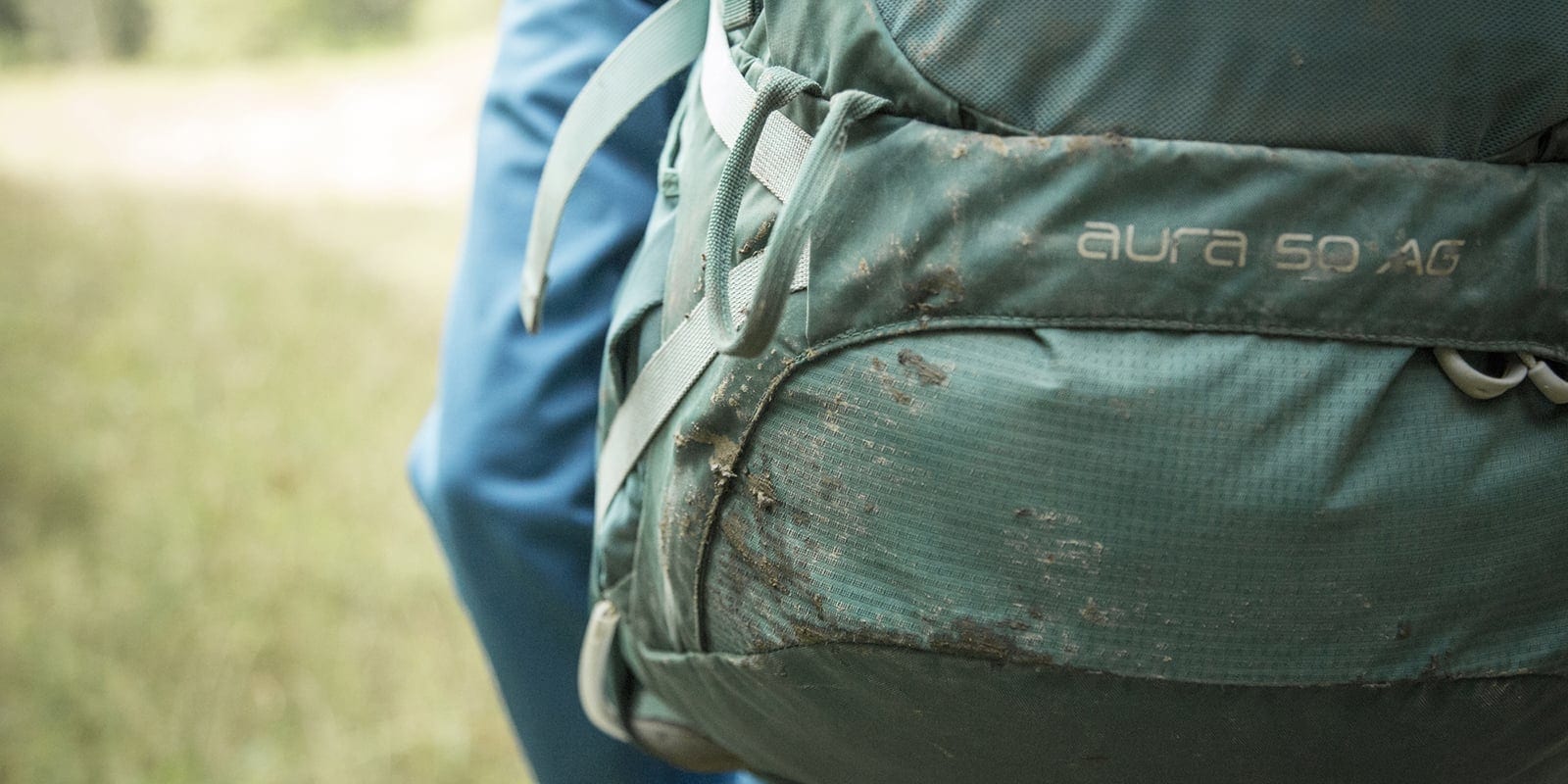To clean mold out of a backpack, first, empty it completely and brush off loose mold using a stiff brush. Then, wash it with a mixture of hot water and detergent.
Mold can quickly become a nuisance, especially when it infiltrates items we use daily like backpacks. Tackling this issue promptly prevents damage to the fabric and ensures the health risks associated with mold exposure are minimized. Starting with a thorough emptying of the backpack is crucial to address every nook where mold might lurk.
A stiff brush is instrumental in removing mold spores before the washing process. This preliminary step aids in preventing the spread of mold during the subsequent cleaning procedure. A well-maintained backpack not only prolongs its lifespan but also contributes to a cleaner, healthier environment for your belongings.
Introduction To Mold In Backpacks
Mold in backpacks can be a hidden nuisance. This uninvited guest can damage fabric and cause health issues. Understanding how mold takes hold in what should be a safe space for your belongings is key. Let’s explore what causes mold and how to spot it early.
Understanding Mold: Types And Health Risks
- Mold is a fungus that grows in multicellular structures called hyphae.
- Various types include Aspergillus, Penicillium, and black mold (Stachybotrys chartarum).
- Health risks include allergies, asthma, and other respiratory issues.
- Severity can depend on mold type and individual sensitivity.
Causes Of Mold Growth In Backpacks
| Cause | Explanation |
|---|---|
| Moisture | Wet items or spills left inside create a damp environment. |
| Food Residues | Organic matter from snacks or crumbs can feed mold spores. |
| Poor Ventilation | Lack of airflow encourages mold growth. |
| Dark Spaces | Closets or lockers can be breeding grounds for mold. |
Early Detection: Signs Of Mold In Your Backpack
- Check for a musty smell; it’s often the first sign of mold.
- Look for visible spots or discolorations on the fabric.
- Feel for dampness or a change in the texture of materials.
Pre-treatment Steps: Preparing To Clean Your Backpack
Discovering mold in your backpack can be unsettling, but with careful cleaning, you can salvage it. Begin with essential pre-treatment steps to ensure a successful mold removal process. Adhering to these preparations shields you from health risks and preps the backpack for a thorough cleaning.
Emptying And Isolating The Contaminated Backpack
Start by carefully emptying the backpack. Turn it inside out to shake loose any debris. Place contaminated items in a separate plastic bag. Seal the bag to avoid spreading mold spores.
Choosing The Right Cleaning Environment
Choose an outdoor setting or a well-ventilated area to prevent mold spores from contaminating your home. Avoid cleaning in closed, damp spaces to protect your health and home environment.
Gathering Necessary Cleaning Supplies And Protective Gear
- Gloves: Shield hands from mold and cleaning agents.
- Mask: Protect lungs from inhaling mold spores.
- Soft Brush: Dislodge dried mold from the fabric.
- Disinfecting Solution: White vinegar or mold-cleaning solution.
- Sponge: Apply solution without damaging backpack material.
- Bucket: Mix cleaning solution.
Assemble these items before you begin to ease the cleaning process.
Vacuuming To Remove Loose Mold Spores
Use a vacuum with a HEPA filter to suck up loose spores. Focus on seams and crevices where spores may hide. Dispose of the vacuum bag immediately after to stop spores from escaping.
Cleaning Methods To Remove Mold
Cleaning Methods to Remove Mold can refresh and preserve your backpack for further adventures. Combatting mold is vital for hygiene and health. Different approaches cater to distinct levels of infestation and backpack materials. Below are effective strategies.
Hand Washing With Soap And Water: Step-by-step Process
Hand washing is both gentle and efficient for mold removal:
- Empty the backpack, ensuring all pockets are clean.
- Brush off dry mold with a soft bristle brush.
- Prepare a mild detergent solution in warm water.
- Dip a sponge or cloth in the solution, wring out excess moistures, and wipe down the backpack.
- Pay special attention to areas with visible mold.
- Rinse thoroughly with clean water to remove any soap residue.
- Air dry the backpack in a well-ventilated space or outside.
Using Natural Cleaning Agents: Vinegar, Baking Soda, And Lemon
Natural agents are safe and eco-friendly alternatives:
- White vinegar is a potent mold killer. Spray onto the affected areas, let sit for an hour, then wipe clean.
- Baking soda acts as a deodorizer and mold deterrent. Sprinkle on, let rest, and later vacuum the residue.
- For a refreshing scent and mild bleach, lemon juice can be applied to spots, allowed to dry, and then rinsed off.
Incorporating Commercial Mold Removers For Tough Infestations
Stubborn mold demands stronger solutions:
Select a commercial mold remover suited for fabric and follow the instructions precisely. Avoid chlorine bleach as it may damage certain fabrics. Conduct a patch test to safeguard against discoloration.
Consideration Of Different Backpack Materials
Identify your backpack’s material to select the right approach:
| Material | Cleaning Method |
|---|---|
| Nylon | Mild soap and water, avoid hot water |
| Leather | Specialized leather cleaner, soft cloth |
| Canvas | Vinegar solution, scrub gently |
| Polyester | Soap solution, thorough rinse |
Always test a small section before applying any product over the entire backpack!

Credit: www.reddit.com
Post-cleaning Care And Prevention
After removing mold from your backpack, proper care is crucial. This section guides you on keeping the backpack in prime condition, ensuring mold doesn’t return.
Drying The Backpack Thoroughly To Prevent Mold Regrowth
A wet backpack invites mold. Dry your backpack thoroughly after cleaning to prevent mold from coming back.
- Place the backpack in a well-ventilated area or outdoors.
- Turn all pockets inside out and open all compartments.
- Avoid direct sunlight which might damage the fabric.
- Use a fan to speed up the drying process if necessary.
Tips For Maintaining A Mold-free Backpack
Regular maintenance is key to keeping your backpack mold-free. Follow these simple tips:
- Air out the backpack after each use, especially if it was exposed to moisture.
- Store in a dry, clean area to prevent damp conditions.
- Clean spills and dirt immediately to avoid mold growth.
- Consider using moisture absorbers or silica gel packets in your backpack.
When To Consider Professional Cleaning Services Or Replacement
Sometimes, the mold may be too tough for home methods. Professional cleaning or backpack replacement may be necessary.
- Persistent mold smell or stains after cleaning might indicate deeper issues.
- If the backpack’s material is damaged, consider replacing it.
- Professional services can deep clean without harming the backpack.
Conclusion: Maintaining Your Backpack For The Long Haul
Conclusion: Maintaining Your Backpack for the Long Haul involves more than just cleaning mold when it appears. It’s about adopting a routine that ensures the longevity of your backpack. Through regular care and slight lifestyle adjustments, you can keep your backpack in prime condition, mold-free, and ready for any adventure.
The Importance Of Regular Cleaning And Inspection
Regular backpack maintenance prevents mold buildup and fabric degradation. Weekly inspections can identify mold early on, saving you time and preserving your backpack’s material. Set a cleaning schedule, and stick to it — your backpack will thank you!
Lifestyle Changes To Avoid Mold In Backpacks
- Store your backpack in dry, ventilated areas to discourage mold growth.
- Empty it after use, shaking out debris and airing it out.
- For added protection, include moisture-absorbing packets inside your backpack.
Summary Of Key Steps In The Cleaning Process
- Empty the backpack completely, checking all pockets.
- Use a mild detergent and warm water for a gentle clean.
- Scrub mold spots with a soft brush, taking care not to damage the fabric.
- Rinse thoroughly to remove all soap residues.
- Let it air-dry in a well-ventilated area away from direct sunlight.

Credit: www.wikihow.com

Credit: www.rei.com
Frequently Asked Questions For How To Clean Mold Out Of A Backpack
Can You Clean Mold From a Backpack?
Yes, you can clean mold from a backpack. First, brush off loose mold outdoors. Next, use a mixture of warm water and detergent to scrub the affected area. Rinse thoroughly and allow it to air dry completely in a sunny spot. Use vinegar for stubborn mold.
How Do You Get Mold Out Of A Fabric Bag?
To remove mold from a fabric bag, create a solution of equal parts water and distilled white vinegar. Apply the solution directly to the mold spots, gently scrub with a soft brush, and then launder the bag as per care instructions. Dry the bag thoroughly to prevent mold regrowth.
What Removes Mold From Fabric?
White vinegar and baking soda effectively remove mold from fabric. Apply the mixture, then launder the fabric as usual. Using a brush, gently scrub off any persistent mold before washing.
How Do You Clean And Sanitize A Backpack?
Empty the backpack, turning it inside out if possible. Use warm, soapy water and a soft brush to gently clean. Rinse thoroughly. Disinfect with an appropriate spray or wipe. Allow to air dry completely before use.
Conclusion
Tackling backpack mold effectively requires the right approach and materials. By following the simple steps laid out in this guide, you can restore your backpack to pristine condition. Remember, regular cleaning deters mold growth, keeping your gear fresh and ready for your next adventure. Stay vigilant, and happy trails!
As an Amazon Associate, Cleanestor earns from qualifying purchases at no additional cost to you.